
9 Of The Most Bizarre Landmarks In Colorado
Colorado is known for its mountains, ski towns, and national parks, but the state also has a bizarre side that surprises travelers. Beyond the Rocky Mountains and scenic trails, you’ll find places that are strange, creative, and sometimes completely unexplainable. These landmarks were built by dreamers, artists, and eccentrics who turned their imaginations into something real.
Some of these landmarks tell stories of faith and resilience, while others simply make you stop and wonder what you just saw. From a UFO watchtower and a castle made of beer cans to a church built inside a rock, Colorado is full of odd landmarks that turn every road trip into a new discovery. If you think you’ve seen everything the state has to show, these unusual spots might change your mind.
UFO Watchtower (Hooper)
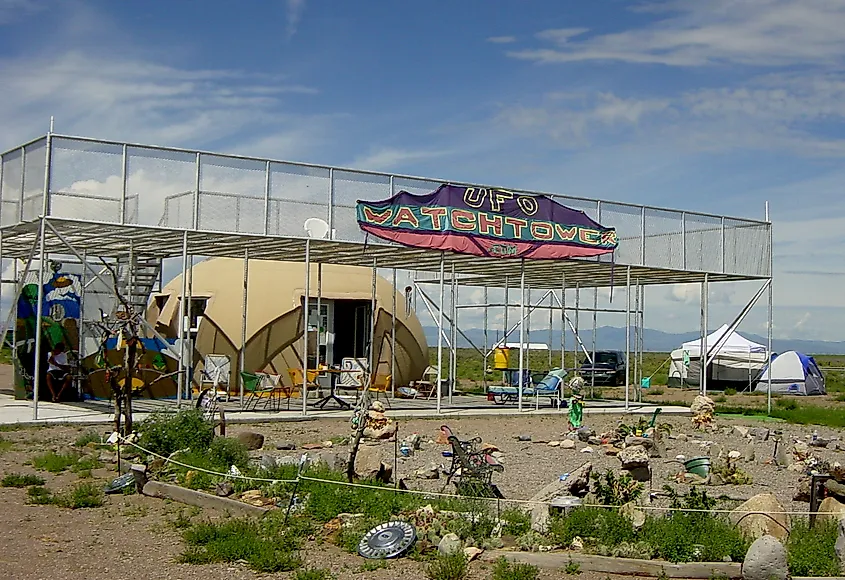
Built by Judy Messoline in 2000 in the San Luis Valley, this watchtower attracts both UFO enthusiasts and curious travelers. The site includes alien-themed artwork, visitor logs filled with sighting stories, and a “healing garden” where guests leave personal offerings. Locals believe the area is a hotspot for UFO activity and even claim it contains interdimensional portals. The open desert landscape near Alamosa gives visitors a clear, wide view of the night sky. Close to the Great Sand Dunes National Park, which is an International Dark Sky Park, the UFO Watchtower is also a perfect place for stargazing.
Bishop Castle (Rye)
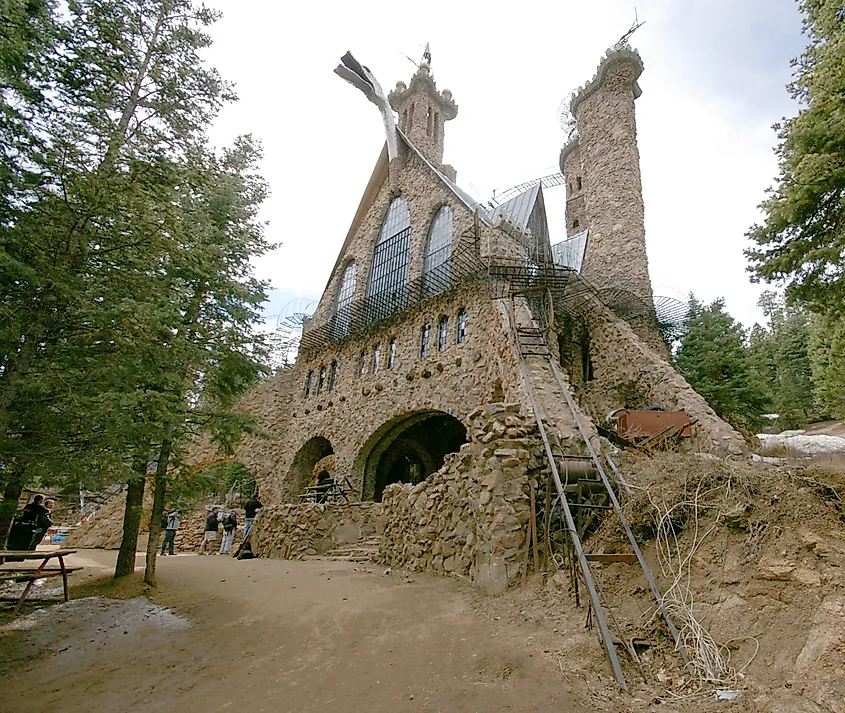
Located at 12705 Highway 165, the castle sits high in the Wet Mountains at just over 9,000 feet. It was built almost entirely by one man, Jim Bishop, who started working on it in 1969 and continued for 50 years. Without blueprints or help, he shaped the massive stone structure by hand, adding towers, arched windows, stained glass, and even a steel dragon head that formerly breathed fire. The project became a lifelong mission for Bishop, who saw it as a symbol of freedom and hard work. Visitors can explore the castle year-round from sunrise to sunset, at their own risk.
Cano’s Castle (Antonito)
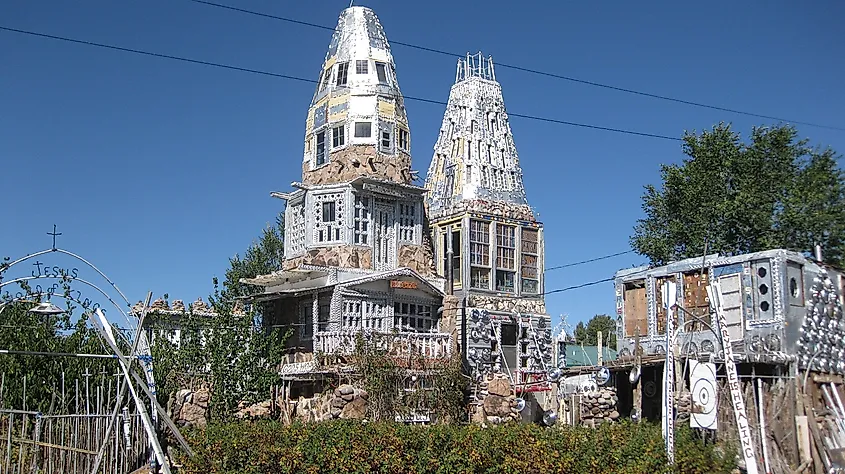
Built by Dominic “Cano” Espinoza, the structure is made from old beer cans, hubcaps, grills, and scrap metal. Cano began building the castle in 1980 as a tribute to God after surviving the Vietnam War. Over time, his creation grew into four gleaming towers called the king, the queen, the rook, and the palace. What began as one man’s project turned into a major roadside attraction and an icon of folk art. In 2022, a fire destroyed Cano’s home, but the main towers survived. Supporters are now helping him rebuild so this unique landmark can continue standing as a symbol of faith, resilience, and creativity in southern Colorado.
Casa Bonita (Lakewood)
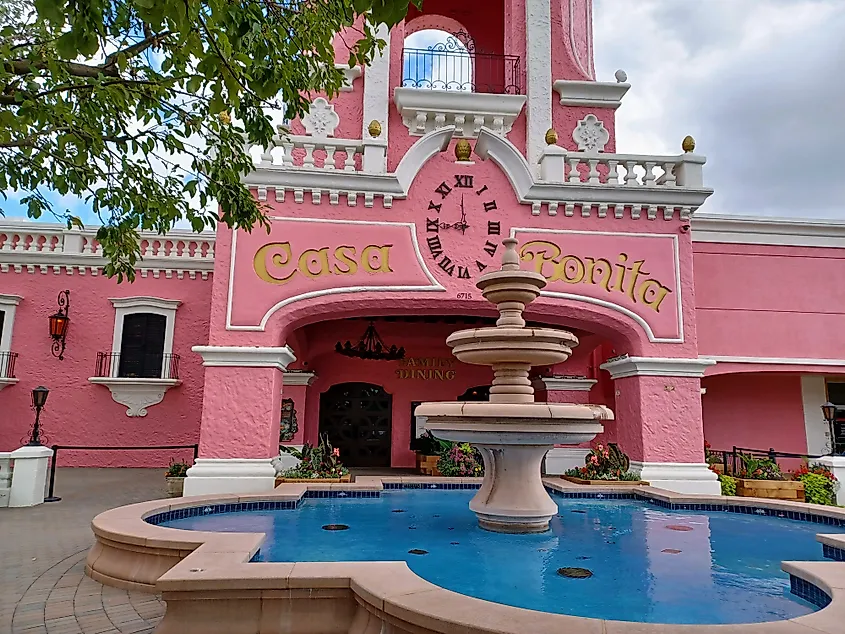
Casa Bonita in Lakewood is a bright pink Mexican restaurant famous for being as wild as it is beloved. Opened in 1974, it quickly became a landmark for its cliff divers, caves, puppet shows, and maze-like dining rooms filled with palm trees and lights. The 30-foot indoor waterfall is modeled after the cliffs of Acapulco, and the gold dome topped with an Aztec statue makes the building hard to miss. After closing during the pandemic, the restaurant went bankrupt and was later bought by South Park creators Trey Parker and Matt Stone. They spent $40 million restoring it and updating the menu with the help of Chef Dana Rodriguez.
Baldpate Inn Key Collection (Estes Park)

Tucked in the Rocky Mountains, the Seven Keys Lodge, once known as the Baldpate Inn, holds one of the most unusual collections in the world: more than 20,000 keys from every corner of the globe. Visitors can spot keys to Westminster Abbey, Frankenstein’s Castle, Mozart’s wine cellar, and even Adolf Hitler’s bunker. The U.S. section includes keys from the Pentagon and the White House bathroom. The collection began in 1917 when brothers Charles and Gordon Mace opened the Baldpate Inn, inspired by the 1913 mystery novel "Seven Keys to Baldpate." Guests began donating keys over the years, turning the idea into a tradition.
Tiny Town & Railroad (Morrison)

Tiny Town & Railroad began in 1915 when George Turner started building a miniature village, then called Turnerville, to fascinate his young daughter. By the 1920s, it had grown into a full attraction with more than 100 small buildings, a grocery store, church, and hotel, drawing over 20,000 visitors a year. Through floods, fires, and highway rerouting, Tiny Town was repeatedly damaged and rebuilt by volunteers and local families. In the 1980s, the Northern Colorado Chapter of the Institute of Real Estate Management helped restore the site, and by 1991, over 100,000 people visited in one year. Today, Tiny Town has more than 90 colorful miniature buildings, a working train, and exhibits from the original 1920s village.
Carousel of Happiness (Nederland)
The carousel began as a Charles Looff creation from the early 1900s, once housed in Utah’s Great Saltair Park. After surviving fires, storms, and decades of disuse, it was rescued in 1986 by Vietnam veteran Scott Harrison. Inspired by a peaceful vision from his time in the war, Scott spent 26 years hand-carving more than 50 wooden animals, including a moose, rabbit, and gorilla. With help from locals, he restored the original frame and added new details like reclaimed pine flooring and historic paintings. It reopened on Memorial Day 2010, spinning once again to the sound of an old Wurlitzer band organ.
Royal Gorge Bridge Dinosaur Statue (Canon City)
The Royal Gorge Dinosaur Experience in Canon City is hard to miss, especially with the towering T-Rex statue that greets visitors near Colorado’s highest suspension bridge. The museum and outdoor exhibit were created by David and Zach Reynolds, a father and son team with deep local roots and a lifelong passion for fossils. Their family’s connection to paleontology goes back to Zach’s grandfather, Peter Allen, who joined paleontologist Fred Kessler on fossil digs around the Garden Park Fossil Area in the mid-1900s. Zach studied geology before returning home to build the museum with his father in 2016. The site blends science, history, and hands-on exhibits for all ages, making it both educational and a little bit quirky.
Saint Catherine's Chapel on the Rock (Allenspark)
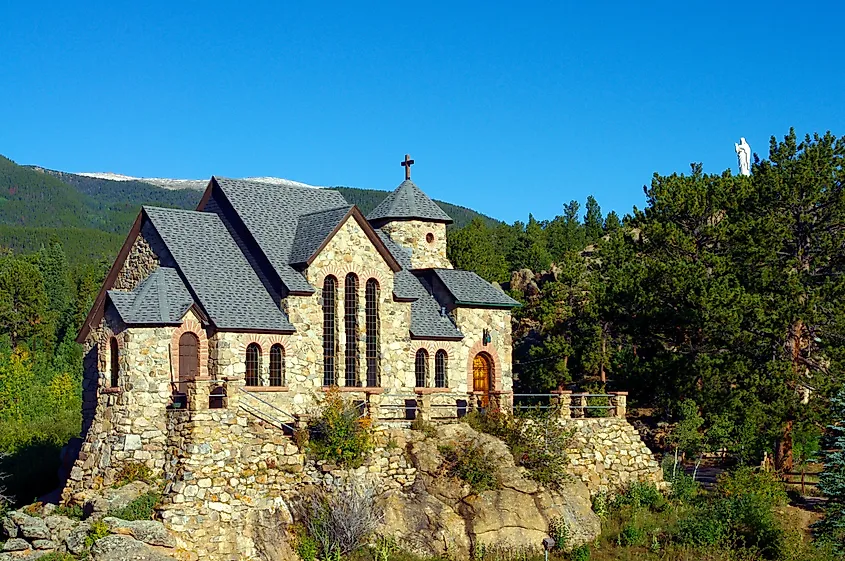
Chapel on the Rock, officially called Saint Catherine of Siena Chapel, sits on a granite outcrop in Allenspark. It looks as if it grew straight from the mountain. The idea for the chapel came in 1916 when Monsignor Joseph Bosetti saw the rock and was inspired by the Bible verse, “Upon this rock I will build my church.” Lack of funds delayed construction until 1936, when Mr. and Mrs. Oscar Malo donated the land. Since then, the chapel has survived floods, fires, and landslides that damaged everything around it but never the building itself. Pope John Paul II visited and blessed it in 1993.
Colorado’s landmarks show that the state’s creativity reaches far beyond its natural beauty. Each of these places was built by someone with a wild idea and the determination to make it real. Some, like Bishop Castle and Cano’s Castle, began as personal projects and grew into massive attractions. Others, like the UFO Watchtower and Carousel of Happiness, mix imagination with hope, faith, or healing. Together they form a strange and fascinating map of Colorado’s history and personality.











